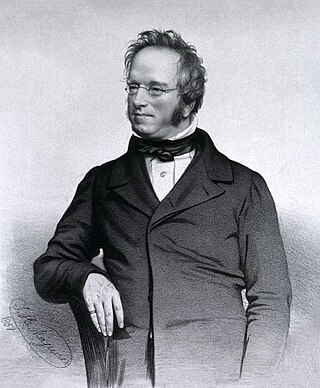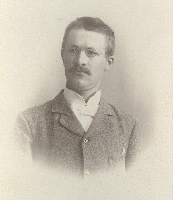
Viverridae is a family of small to medium-sized, feliform mammals. The viverrids comprise 33 species placed in 14 genera. This family was named and first described by John Edward Gray in 1821. Viverrids occur all over Africa, southern Europe, and South and Southeast Asia, across the Wallace Line.

A holotype is a single physical example of an organism used when the species was formally described. It is either the single such physical example or one of several examples, but explicitly designated as the holotype. Under the International Code of Zoological Nomenclature (ICZN), a holotype is one of several kinds of name-bearing types. In the International Code of Nomenclature for algae, fungi, and plants (ICN) and ICZN, the definitions of types are similar in intent but not identical in terminology or underlying concept.

John Edward Gray was a British zoologist. He was the elder brother of zoologist George Robert Gray and son of the pharmacologist and botanist Samuel Frederick Gray (1766–1828). The standard author abbreviation J.E.Gray is used to indicate this person as the author when citing a botanical name. The same is used for a zoological name.

Lionel Walter Rothschild, 2nd Baron Rothschild, Baron de Rothschild, was a British banker, politician, zoologist and soldier, who was a member of the Rothschild family. As a Zionist leader, he was presented with the Balfour Declaration, which pledged British support for a Jewish national home in Palestine. Rothschild was the president of the Board of Deputies of British Jews from 1925 to 1926.

Albert Karl Ludwig Gotthilf Günther, also Albert Charles Lewis Gotthilf Günther, was a German-born British zoologist, ichthyologist, and herpetologist. Günther is ranked the second-most productive reptile taxonomist with more than 340 reptile species described.

Arthur Gardiner Butler F.L.S., F.Z.S. was an English entomologist, arachnologist and ornithologist. He worked at the British Museum on the taxonomy of birds, insects, and spiders.

Embrik Strand was an entomologist and arachnologist who classified many insect and spider species, including the greenbottle blue tarantula.

Samuel Walton Garman, or "Garmann" as he sometimes styled himself, was an American naturalist and zoologist. He became noted as an ichthyologist and herpetologist.

The Zoological Survey of India (ZSI), founded on 1 July 1916 by the Ministry of Environment, Forest and Climate Change of the Government of India as a premier Indian organisation in zoological research and studies to promote the survey, exploration and research of the fauna in the country.

The Museum of Comparative Zoology is a zoology museum located on the grounds of Harvard University in Cambridge, Massachusetts. It is one of three natural-history research museums at Harvard, whose public face is the Harvard Museum of Natural History. Harvard MCZ's collections consist of some 21 million specimens, of which several thousand are on rotating display at the public museum. In July 2021, Gonzalo Giribet, Alexander Agassiz Professor of Zoology at Harvard and Curator of Invertebrate Zoology, was announced as the new director of the museum.

The Zoological Museum of Kiel University is a zoological museum in Kiel, Germany. It was founded by naturalist Karl Möbius, and architect Martin Gropius designed the building. The exhibitions display systematics, evolution, tropical and German fauna, butterfly ecology and history of zoology in Kiel. The museum is part of the University of Kiel and participates in the Museen am Meer association.
Arthur Loveridge was a British biologist and herpetologist who wrote about animals in East Africa, particularly Tanzania, and New Guinea. He gave scientific names to several gecko species in the region.
The Raffles Bulletin of Zoology is a peer-reviewed open-access scientific journal published by the Lee Kong Chian Natural History Museum at the National University of Singapore.

The University Museum of Zoology is a museum of the University of Cambridge and part of the research community of the Department of Zoology. The public is welcome and admission is free (2018). The Museum of Zoology is in the David Attenborough Building, formerly known as the Arup Building, on the New Museums Site, just north of Downing Street in central Cambridge, England. The building also provides a home for the Cambridge Conservation Initiative, a biodiversity project.

Thrissur Zoo or State Museum & Zoo, Thrissur is a 13.5-acre (5.5 ha) zoo that opened in 1885 in a small area called Chembukkavu, in the heart of Thrissur City, Kerala, India. It is one of the oldest zoos in the country and is home to a wide variety of animals, reptiles, and birds. The zoo compound includes a natural history museum and an art museum that showcase the social and cultural heritage of the region. The Thrissur Zoo is 2 kilometres (1.2 mi) from the Thrissur City center and is open from 10:00 AM till 5:15 PM, except on Mondays. Being one of the two Zoological Parks in the state of Kerala, it sees many visitors on a regularly. Still and video cameras are allowed in the park for a small fee.

A zoological specimen is an animal or part of an animal preserved for scientific use. Various uses are: to verify the identity of a (species), to allow study, increase public knowledge of zoology. Zoological specimens are extremely diverse. Examples are bird and mammal study skins, mounted specimens, skeletal material, casts, pinned insects, dried material, animals preserved in liquid preservatives, and microscope slides. Natural history museums are repositories of zoological specimens

The Natural History Museum Denmark is a natural history museum located in Copenhagen, Denmark. It is affiliated with the University of Copenhagen
The D'Arcy Thompson Zoology Museum is a museum of zoology at the University of Dundee in Scotland.
Bulletin of the Natural History Museum, formerly known as Bulletin of the British Museum is a series of scientific journals published by the British Museum, and later by the Natural History Museum of London. Titles in the series included
















